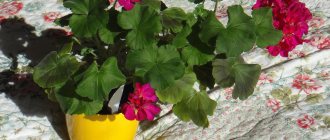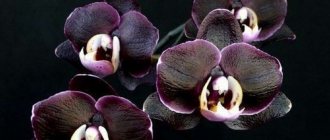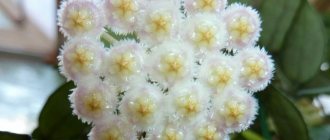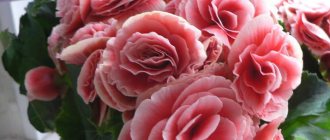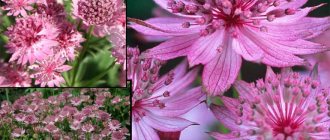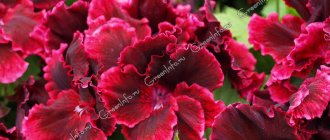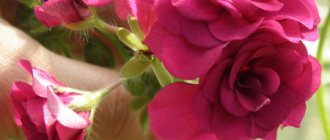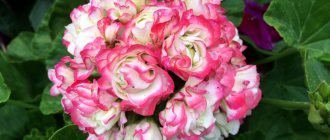Terry pelargonium is a large group of plants. These representatives include specimens with large or small flowers, which have 8 or more petals of various shades in the corolla. Many gardeners are mistaken in thinking that this is a group of exclusively zonal subspecies. In fact, there are varieties of other varieties with densely double rosettes.
Terry geranium with roses is a popular crop and can be easily grown at home. Properly organized care allows you to ensure magnificent lush flowering for 9-10 months. We also recommend choosing suitable varieties and their cultivars. Compliance with the parameters of adaptability to the climatic conditions of a particular zone allows you to grow this crop as balcony gardening or for landscaping terraces, verandas and even border groups.
Read the simple rules for organizing their care at home and in the open ground. Study the varieties and their descriptions.
Look at the flowers of terry pelargonium in the photo illustrating the beauty of these plants:
Botanical description and history
Pelargonium terry is an indoor (sometimes garden) plant that belongs to the Geraniaceae family. In the natural environment they are found in the form of subshrubs, and a little less often - shrubs. There are both annual and perennial varieties. Among these varieties there are also terry varieties, which in turn are also divided into subspecies:
- royal;
- zonal;
- ivy-shaped (ampeloid) and so on.
The variety received its name due to the special arrangement of petals - in one row there can be up to eight petals at the same time.
They all grow not side by side, but as if investing in each other. Due to this, the bud looks very lush. The birthplace of the described flower is considered to be South Africa, as well as India. The plant first appeared in European countries at the end of the 18th century. Residents of Europe immediately appreciated the plant and began planting them en masse in their flower beds and window sills. Over time, pelargonium was named a symbol of the Victorian era and became an attribute of comfort in every home.
What should the soil be like?
What is required from the soil:
- fertility;
- looseness;
- universal composition containing peat and sand;
- It is allowed to add mineral fertilizer to the soil.
The soil for the plant must contain both peat and sand.
Interesting!
In order for water to easily flow out through the holes, it is recommended to create a drainage layer using large expanded clay that spreads at the bottom of the pot. Similar material is sold in all flower shops.
Use of expanded clay
Description of appearance and features
Terry pelargoniums are distinguished by a large number of petals, which are collected into buds similar to umbrellas. The outer side of the petal is always slightly lighter than the inner. Due to this, additional volume is added to the entire flower.
The shoot of the flower grows straight, it is quite strong and does not require additional support. The leaf blades feel a little velvety to the touch. The buds can be found in a variety of colors - from pure white to deep purple.
The peculiarity of the plant is its tart aroma, which is not suitable for everyone, and some, on the contrary, consider this feature an advantage.
What does terry pelargonium look like, what features does it have?
This flower has many petals forming an umbrella-shaped inflorescence, similar to a round cap. The petals are lighter at the bottom, which gives them fluffiness.
The flower is placed on a concentrated straight stem with lush leaves. If you touch them, you can feel some velvetyness. Inflorescences have any floral colors.
What does pelargonium look like?
Pelargonium is not bad for everyone: some may get a headache due to the tart smell of the foliage. Because of it, insects like flies and moths avoid being near the flower. But the smell of the plant has a beneficial effect on some people:
- calms;
- treats migraine;
- helps to fall asleep with insomnia;
- improves the quality of life for hypertensive patients and people suffering from pathologies of the heart and blood vessels.
This plant has some medicinal effects.
Fascinatingly!
Caring for the plant is not too difficult; it loves light and can survive drought.
Description and photos of varieties
Purple
This variety includes many more subspecies . For example:
- Brookside Fantasy (light violet-lilac color, rather lush, terry brushes);
- Amethyst (lilac color);
- Lara Gem (lilac shade);
- Bold Pixie (colors vary from lilac to purple);
- PAC Icecrystal (violet-lilac).
White
This type, in turn, is also divided into groups:
- Granny Barter (in appearance they are somewhat reminiscent of the students’ snow-white bows);
- Artic Princess (pure white buds, similar to a ball);
- Delta Pearl;
- PAC Blanca;
- Dowepoint;
- Destiny.
Angel
This variety deserves special attention. In appearance it resembles royal pelargonium. The only difference is in the shape of the bush - in Angel it curls, and does not grow as a lush bush.
Another distinctive feature is the small size of the flowers - usually their diameter does not exceed two centimeters. The height of the bush reaches 35 centimeters. If it goes higher, it should be cut off, otherwise all the decorativeness will disappear. The shade of the petal can be different - from soft pink to lilac. In some cases, there are species with spots and stripes on the inside of the petal.
Home varieties
There are many different varieties that are presented in the photo in our issue. Many of them are very rare varieties found exclusively in private collections. Flower growers who are fans of pelargonium often face the problem that it is simply impossible to find seeds of the desired variety, and rooted cuttings are much more expensive. Plus, transporting a plant to distant regions can harm the young seedling and cause it to become ill and even die on the way to its new owner.
Despite this, home perennials do not go out of fashion and their roses are adored by those who managed to get their hands on a plant they liked. Next, we will consider the most successful breeding varieties of terry pelargonium or geranium.
Many flower growers are in search of a very rare crop with purple double flowers. Such varieties, if they exist, are considered very difficult to breed. The purple hue is not natural. Most often there are perennials with pink, white, greenish, lilac or purple buds. However, there is one wonderful variety of purple terry pelargonium called “PAC Blue Sybil” or “Fibrix”. This large plant belongs to the group of ivy-leaved geraniums. Pink buds with petals of a delicate lilac hue. The formed bush is compact and is characterized by long, abundant flowering with caps of flowers.
'Borthwood Stellar' is a beautiful dwarf with star-shaped flowers that look like a fluffy carnation. The petals of the corolla are of an unusual shape with pointed tips, dissected into several neat lobes. The flowers of the plant can be colored lilac, violet or intense pink.
“Colorado Compact” is an amazing variety, a characteristic feature is the neatness of the plant, it easily lends itself to shaping pruning . The flowers are semi-double pinkish-lilac with a white center. On the surface of the corolla petals you can see several randomly located red spots. Flowering is very abundant, at this time large inflorescences are formed - dense caps at the tops of the stems.
The great advantage of the flower collection and the dream of flower growers is the “Apple Blossom Rosebud” variety. This is a hybrid of the rosebud group of zonal pelargonium. The bush is medium in size, reaches a maximum height of 50-60 cm. The flowers are double, very beautiful due to the smooth transition of the green shade of the middle to white. The edges of the petals of the corolla have an uneven edging of raspberry color. During flowering, it seems as if large roses, tightly packed into a tight bouquet, bloomed at the tops of the stems.
“Variety Denise” is a large zonal pelargonium, its height can reach 70-90 cm. The flowers are very large, densely double. The perennial blooms with delicate buds of peach or apricot-pink. The outer side of the petals is painted in a lighter color. The flowers are collected in dense inflorescences “brushes”, similar to bouquets of miniature roses. The umbels of the buds are very large.
"Highfield's Fancy" is a variety of the zonal terry group. The bush is compact and not prone to rapid growth. The flowers are very large, pink or deep crimson. Some representatives may have buds with a characteristic purple or lilac tint. The central part of the flower is always lighter than the edges of the petals; it can be completely white.
Another variety of Highfield's hybrid group is “Prima Donna”. The plant is very elegant and beautiful. A perennial with a small, compact shape, it blooms very readily. During the flowering period, “umbrellas” of unusual flowers with white petals and a bright crimson or pink center are formed at the tops of the stems. It seems as if the petals were brushed with paint at the base.
“Pink Rambler” is a double pelargonium, most often gardeners recognize it as a bright representative of the zonal rosebud group. Geranium with large rosettes of pure pink color. Small specks and white spots are randomly located on the petals.
"Nan West" is a variety of the Bird's Eggs subgroup. Some gardeners classify the plant as a member of the angel pelargonium group due to the large petals of the corolla. The plant forms a good bush with strong branching stems. Flowering is very abundant: white petals densely fill the corolla. The buds are collected in racemose inflorescences similar to bouquets of roses. The surface of the petals is most often speckled with pink or red, as can be seen in the photo of terry pelargonium.
"Pebbles" is an elegant variety of zonal pelargoniums. A miniature plant with large inflorescences of double pink or crimson buds.
"Lara Gem" is a purple form of the plant with beautiful large corolla petals. The variety was obtained by crossing the ivy-leaved and zonal species. The bush is compact in shape, but without proper care it has the ability to grow quickly and loses its external decorative effect.
“Shelk Moira” is a dwarf of Russian selection. The inflorescences of the plant are very dense, they are collected from densely double flowers with pink or wavy white petals.
"Brook Side Fantasy" - zonal pelargonium. The plant forms a small compact bush with rich green foliage. Beautiful inflorescences of a soft pink hue are formed at the tops of the stems.
“Le Pirat” is a type of ampelous terry crop that belongs to the ivy-leaved group of geraniums. The inflorescences are very lush red or burgundy. If desired, the variety can be grown as a dwarf flowering plant. Perennials of this variety bloom very readily and do not require care. Flowers form very quickly and stay on the bush for a very long time.
"Maleorka" - characteristic abundant flowering, lasting for several months in a row, during which beautiful unusual flowers are formed . These plants belong to the cactus group of zonal crops. The flower's petals are jagged at the edges and are striped with red, green and white. If you grow the perennial in a sunny place, it will retain its compact appearance. Without the sun, the shoots of the plant stretch out, lose some of their foliage and become less decorative.
“PAC Viva Maria” is a variety with long-lasting, spectacular flowering with large, luxurious “umbrella” inflorescences. The bush is formed compact, not large in size. The petals of the terry corolla are white with a characteristic uneven spot of crimson at the base. Each flower has a bright pink “eye”.
"Norrland" is an amazingly beautiful variety, belongs to the group of zonal pelargoniums and emerald foliage. The plant has very strong powerful stems. The flowers are double, similar in shape to miniature peonies. The buds are collected in very lush beautiful inflorescences.
"Passat" is an ornamental deciduous plant with green corrugated foliage. The double flowers look like pink fluffy pompoms.
“Granny Barter” is a pelargonium with white fluffy flowers collected in large large inflorescences. The apical “umbrellas” look like ceremonial bows due to the snow-white hue of the buds. The flowers are densely double. Medium sized bush.
"Ainsdale Duke" is a powerful plant with very strong long stems. Dense foliage forms a beautiful openwork green crown. The flowers are very showy and deep red. Unlike other pelargoniums, this variety looks very picturesque and all other indoor flowers fade against its background.
How to plant correctly?
Choosing a location and lighting
This pelargonium requires a lot of light. With its deficiency, the foliage begins to turn yellow and, over time, completely fall off. Therefore, the most suitable place for a flower is the southern and eastern sides of the room. In winter, you will have to resort to additional lighting.
Important! Make sure that artificial lighting lamps do not leave burns on the surface of terry pelargonium.
Soil requirements
To grow a healthy and profusely flowering plant, you must adhere to the following rules when preparing the soil:
- The substrate must be fertile and loose.
- You can use universal soil purchased at the store, but add peat and coarse river sand.
- Before planting, add mineral fertilizers to the substrate.
- Be sure to put a drainage layer, which can be made from expanded clay pebbles.
- Soil acidity should be at a neutral level.
How to care for pelargonium at home after purchase
Geranium is a very heat-loving perennial plant that does not tolerate temperatures dropping to 0 °C. It needs room temperature, good lighting, and regular watering. The plant requires simple care and good conditions. It can be grown both in pots and in open ground.
If the lighting is not enough, you need to illuminate the pelargonium with a lamp. It is worth watering with filtered or infused slightly warm water. In spring and summer, geraniums are watered once every three days, and in autumn and winter - once every 10 days or 2 weeks. Water should not stagnate in the pan. You cannot spray geranium. The plant needs to be trimmed 1-2 times a year as it grows.
Is a transplant necessary?
Pelargonium needs to be replanted when its roots grow and the pot becomes too small for it. It can be replanted in early spring: from late February to April. Initially, this plant needs to be planted in a small pot.
How to determine if it's time to replant geraniums:
- the flower grows too slowly;
- the soil dries out quickly;
- roots are coming out of the pot.
To replant a geranium, you need to remove it from the pot along with the root and soil and place everything in a new pot with ready-made soil. After planting, the flower is watered, then placed in a bright place where there are no drafts.
What should the soil be like?
Terry geranium loves light soil types that can conduct air. The acidity level (pH) should be 5.5–6.5. You can prepare soil from several components:
The soil is also suitable for succulents. Experienced flower growers say that it is better to prepare the soil yourself, but this takes time. All components must rest for a year, then they must be sterilized, dried, and sifted. It is very important to mix the soil components in the required proportions. Good drainage is also needed.
Important! Purchased soils have a sufficient degree of fertility suitable for geraniums. In stores you can find special mixtures for pelargoniums.
White terry geranium
Home care rules
Watering
In summer, the soil is moistened 3-4 times a week. It is better to do this with settled water at room temperature.
It is important to ensure that water does not accumulate in the soil. The most optimal method of watering is through a tray. This way the plant will take the required amount of water, and you will drain the excess. In winter, the frequency of watering is reduced to once a week.
Air temperature
Pelargonium feels best in average climates. Therefore, you need to provide it with a temperature within 20-25 degrees. If the indicators increase, it is worth cooling the plant a little. To do this, you can spray the air around.
Humidity
This indicator should always be at the level of 65-70%, try not to raise it higher. But if the room is very stuffy, you can slightly raise the humidity , but you do not need to spray the plant itself.
Trimming
Terry pelargonium is a plant that requires constant pruning in order for the bush to form the correct shape. As soon as the florist sees that the shoots have become too long and the flower loses its decorative effect.
This procedure is carried out with a well-sharpened instrument so as not to injure parts of the pelargonium. After pruning, exposed areas can be treated with insecticides to protect the plant from infection.
Top dressing
Fertilize the plant twice a month. For this they use ready-made mineral complexes, which can be purchased at any flower shop. However, make sure that the fertilizer contains the following in equal proportions:
- potassium;
- magnesium;
- phosphorus.
In winter, the subcortex is completely stopped , allowing the plant to rest and recover.
Reference! It is necessary to regularly ventilate the room so that the air does not stagnate in it and various parasites do not appear. But make sure that a harmful draft does not form.
Description of the plant
In total, botanists know about 250 species of pelargonium.
They occur in the form of a herbaceous plant, subshrub and small vine. Depending on the group, pelargonium can reach 50 centimeters in height, like the zonal ones, or stretch up to a meter, like the ivy-leaved pelargoniums. The shape of the leaf plate is also very diverse. Rosebud pelargoniums in the zonal group are characterized by green leaves with a dark border, covered with fine down. The edges of the leaf plate are wavy, smoothly rounded. In the group of ampelous pelargoniums, the leaves will be thick and fleshy, with a glossy surface, almost without hairs. There are varieties with variegated foliage. But the plant acquired a special love among gardeners and its name thanks to its buds. They consist of many petals, when opening, they take on a shape similar to a rose, but unlike it, the buds are collected in an umbrella inflorescence, rising on a long peduncle. Moreover, the plant is not so demanding to care for. Pelargonium petals are painted in a variety of colors, when fully blooming, the inflorescence takes the shape of a ball. After flowering, a capsule fruit is formed. The sepals are retained on it, and the opening occurs from the tip of the capsule to the base.
Beneficial features
Rosemary and geranium oils are used as a stimulator of love energy. The oils are mixed in equal quantities, but do not shake. Can be applied to the skin as perfume or used in an aroma lamp.
All parts of pelargonium are used as medicinal raw materials. Essential oil has a wide range of uses.
It promotes:
- increasing mental activity and physical activity;
- restoration of the skin after thermal burns and frostbite;
- healing in the treatment of neuritis and hormonal problems in women;
- victory over infertility;
- normalize high blood pressure.
The oil is used to prevent viral diseases and relieve inflammatory processes and obsessive depression. Often used in cosmetology for problematic and oily skin, as the oil has a soothing, moisturizing, and mild anti-aging effect. It can smooth out small facial wrinkles.
You can use the oil on its own (mixed with a base oil) or in combination with other oils, as well as enrich creams and shampoos with it.
Cosmetologists treat diseases such as:
- psoriasis;
- eczema;
- skin fungus;
- herpes.
Diseases and pests
Often, only errors in care lead to problems with terry Pelargonium. It can be attacked by the following parasites:
- Root rot. The reason for the development is excess moisture in the flowerpot. This disease cannot be cured. Therefore, the affected plant is immediately destroyed so that other flowers do not become infected.
- Gray mold. Appears on leaf plates. The way to fight is as follows:
- Watering stops.
Affected foliage is removed.
- Treatment with an antifungal agent is carried out.
- Blackleg. It primarily affects only shoots. It develops due to excess moisture in the flowerpot or from other affected plants. In this situation, there is only one way out - to get rid of the soil and the plant itself. However, in order to preserve terry Pelargonium, you can cut healthy cuttings from it and root it. Prevention of infection is disinfection of the soil.
- Lengthening the stems, which also remain without leaves. This process indicates a lack of lighting.
After this, the pelargonium is placed in a well-lit place.
Technology for growing pelargonium from seeds
Two methods are suitable for growing: cuttings or seeds. And although the first one is easier, with the help of the second one you can grow a healthy, strong and beautiful bush.
- Do not purchase raw materials from unverified places (in markets, from intermediaries or on Chinese Internet resources). Buy the product in a special store.
- Wrap the seeds in damp gauze. Leave them for 7-10 days, preferably so that the air in the room is not dry. Keep an eye on the fabric and add liquid as required.
- When the raw materials swell, plant them in the prepared soil. Cover the container with film and water the soil regularly.
- When a sprout appears and four obvious leaves grow on it, the film can be removed and the seedlings can be planted in separate pots.
- Place the grown bush in a pot of the required volume. Be sure to take the first one from clay so that air can penetrate inside better. Since geranium is just forming, it is extremely dangerous if its root system rots. High-quality drainage with a layer of 3 cm will also help prevent this.
Features of reproduction
To do this, you can use two methods - sowing seeds and cuttings.
By cuttings
- It is best to cut off the shoot in the spring. It is necessary to select a cutting 5-7 centimeters long from the lateral or apical shoots. Do not forget that pruning is carried out only with a well-sharpened tool.
- After this, you need to get rid of the lower leaves on the shoot, leaving only the top two or three.
The finished shoot is dried in the open air for several hours.- It wouldn’t hurt to treat the cut areas with an insecticide or just wood ash.
- The container for planting is chosen to be very small. A regular plastic cup will do. You need to make several holes at the bottom for air circulation or excess liquid to drain.
- Before planting, the soil is disinfected. To do this, it is treated with a weak solution of potassium permanganate.
- After drying, the cuttings are placed in a container.
- The flower pot is placed in a well-lit place, but so that the sun's rays do not fall on it.
- Water the cuttings as needed - only after the soil has dried.
- The air temperature should not fall below 15 degrees Celsius.
Often, after three to four weeks, the cuttings take root.
Seeds
If the gardener decides to propagate terry pelargonium using seeds, he should adhere to some rules.
- The time for sowing seeds is from the beginning of autumn to the end of spring. It is advisable to use purchased materials for this.
- The usual universal soil will do, but you will need to add a little peat to it.
- If you collect seeds from flowering plants yourself, it is better to wipe them with sandpaper for better germination.
- The seeds are planted shallow in the ground. A space of five centimeters is left between the planting material. After this, the soil is moistened with a spray bottle.
- The container with seeds is covered with film or glass.
- The temperature should be maintained at 20 degrees.
- Within a week you will be able to see the first shoots.
- The seedlings are planted in separate containers only after three or four leaves appear on them.
Pelargonium is one of the few plants that captivates not only with its appearance, but also with its pleasant aroma. Delicate buds, distinguished by a variety of shades, make this flower one of the most popular among flower growers in many countries of the world. We recommend reading our materials on growing species such as: Bold, Patricia Andrea, Rococo, Stellar, Silk, Pak Viva, April Snow, Red Pandora, Edwards Elegance and Tuscany, Ludwigsburg Flyer.
Terry pelargonium is one of the most beautiful representatives of its family. Which also does not require special care. You just have to follow a few simple rules, and the flower will thank you with its excellent appearance.
Geranium with roses - a little about the types
Flower growers have long known that all representatives of this family are mistakenly called geraniums. But there is a difference between geraniums:
Lat. Pelargonium (photo)
Geranium. A perennial plant that overwinters at temperatures down to -30 °C. It grows under natural conditions in meadows and forest edges, where there is a lot of sun.
It has been in gardens for a long time and is considered one of the best long-flowering plants for decorating flower beds.
Pelargonium. The flower comes from southern countries. When the air temperature is below zero, it freezes completely. In areas with cold winters it can only be grown indoors.
There are several types of pelargonium:
- Ivy-leaved
- Royal
- Zonal
- Fragrant
- Deacons
- Angels
Each species has its own characteristics and different flowers. The most interesting of all are pelargoniums with flowers that look like miniature roses.
Varieties with such flowers can be found in zonal and ivy-leaved species. Zonal pelargoniums with pink flowers are called rosebuds. The first varieties appeared as a result of accidental cross-pollination or mutation of ordinary pelargoniums in the middle of the 19th century.
The very first variety, created in 1870, was called Appleblossom Rosebud. It still remains one of the favorites for gardeners.
Today there are more than 20 varieties of pink pelargoniums.
From this variety, the gardener will be able to choose for himself, and perhaps want to collect the entire collection.
